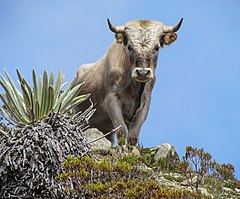Mérida (state)
Template:Infobox Venezuelan state The Bolivarian State of Mérida[1][2] (Spanish: Estado Bolivariano de Mérida), commonly known simply as Mérida State (Spanish: Estado de Mérida, IPA: [esˈtaðo ðe ˈmeɾiða]) is one of the 23 states of Venezuela. The state capital is Mérida, in the Libertador Municipality.
Located in the Western Andean Region, Mérida State covers a total surface area of 11,300 square kilometres (4,363 sq mi), making it the fifteenth-largest in Venezuela. In 2011, had a census population of 828,592, the fourteenth most populous.
Climate and Vegetation
The climate is temperate but in the relatively small area of Mérida state, there are usually several dramatic climatic changes that occur daily. The climate in Mérida city has an average high temperatures between 24 °C and 25 °C, and low temperatures between 14 °C and 16 °C. At higher peaks on the Sierra Nevada de Mérida, temperatures tend to be under 0 °C. El Vigía sees temperatures around 28 °C. It rains almost every late afternoon in January–February. These are the coldest months. In August and September it often rains at night. The vegetation is exuberant and there are many lakes and rivers, a great number of which are well stocked with trout, one of the delicacies of Mérida. The most important river in the state is the "Chama" because a large part of the water resources of Venezuela originates in the Mérida mountains. The state tree is the "Bucare" and the state flower is the "Frailejón", The "Coloradito" contains the tree that is found at the highest altitude in the world. In this mountains habitat the "Oso Frontino" bear and the Condor flies through the skies of the páramos and in the lagoons there are many trout.
Municipalities and municipal seats
- Alberto Adriani (El Vigía)
- Andrés Bello (La Azulita)
- Antonio Pinto Salinas (Santa Cruz de Mora)
- Aricagua (Aricagua)
- Arzobispo Chacón (Canagua)
- Campo Elías (Ejido)
- Caracciolo Parra Olmedo (Tucaní)
- Cardenal Quintero (Santo Domingo)
- Guaraque (Guaraque)
- Julio César Salas (Arapuey)
- Justo Briceño (Torondoy)
- Libertador (Mérida)
- Miranda (Timotes)
- Obispo Ramos de Lora (Santa Elena de Arenales)
- Padre Noguera (Santa María de Caparo)
- Pueblo Llano (Pueblo Llano)
- Rangel (Mucuchíes)
- Rivas Dávila (Bailadores)
- Santos Marquina (Tabay)
- Sucre (Lagunillas)
- Tovar (Tovar)
- Tulio Febres Cordero (Nueva Bolivia)
- Zea (Zea)
-
The Mérida cable car, the highest and longest in the world.
-
Nuestra Señora de las Nieves
-
Castillo San Ignacio
-
Mucubají lagoon, Sierra Nevada National Park.
-
Feral Charolais cattle, from Sierra Nevada,
-
Campos de Mérida
Race and ethnicity
According to the 2011 Census, the racial composition of the population was:[3]
| Racial composition | Population | % |
|---|---|---|
| White | 479,021 | 53.7 |
| Mestizo | — | 42.5 |
| Black | 24,085 | 1.1 |
| Other race | — | 2.7 |
See also
- States of Venezuela
- Nevado
- Merida glaciation
- Sierra Nevada de Merida
- Los Aleros theme park
- Albarregas Metropolitan Park
References
- ^ "Estado Mérida podría cambiar de nombre". Últimas Noticias (in Spanish). Caracas. 25 January 2013. Retrieved 2 January 2016.
- ^ "Consejo Legislativo de Mérida cambiará el nombre del estado". El Universal (in Spanish). Caracas. 31 January 2013. Retrieved 2 January 2016.
- ^ "Resultado Básico del XIV Censo Nacional de Población y Vivienda 2011 (Mayo 2014)" (PDF). Ine.gov.ve. p. 29. Retrieved 8 September 2015.
External links
- Government of Mérida State (in Spanish)






